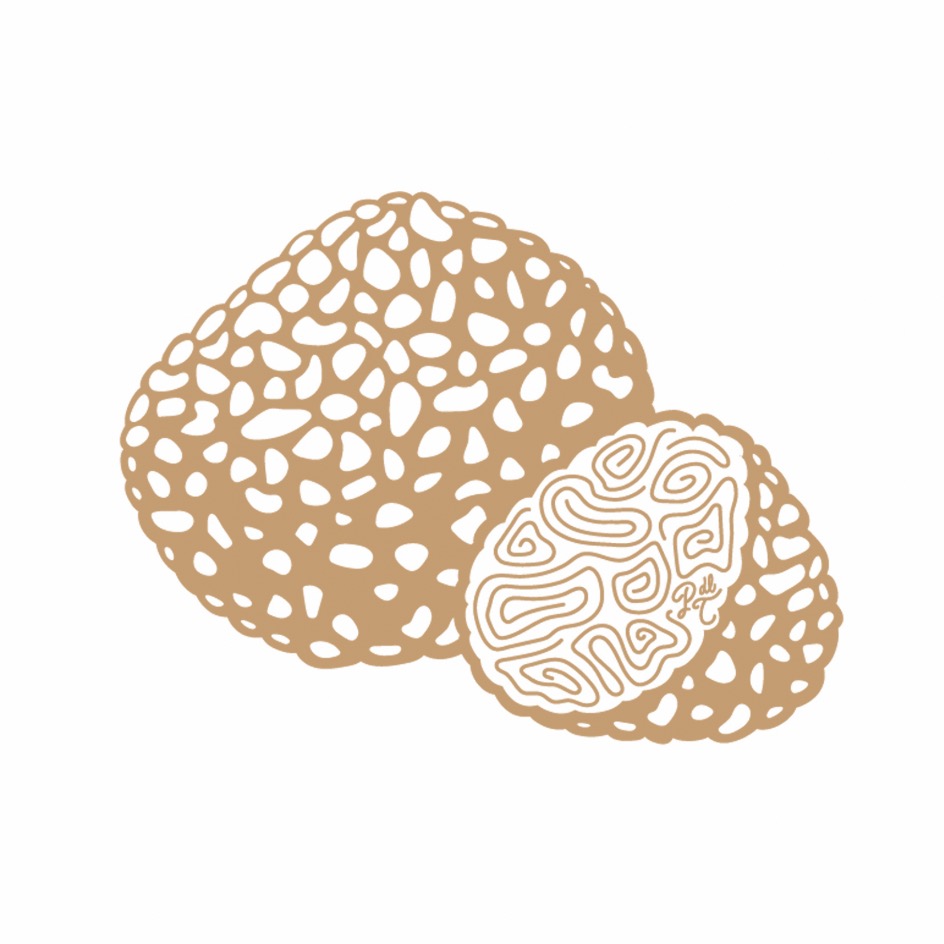Underground Secrets
In the shade of truffle oaks, hidden within the truffières, lie many secrets. Discover the roots of a timeless culinary treasure and the mystery of its life cycle.
Long ago, there was a truffle...

The ancient origins
Like many exceptional products, the truffle has a millennia-old history. The first written traces date back to around 3000 BC in the ancient city of Sumer. Later, in Egypt, Pharaoh Khufu (2600 BC) seemed particularly fond of it. At that time, the truffle was surrounded by mystery: it was believed to emerge where lightning struck the earth. The Egyptians consumed it coated in goose fat, a preparation worthy of this precious delicacy.
A text dating back to 1600 BC describes it as a "mysterious product of the earth," and Theophrastus (372-287 BC) referred to it as a "rootless plant, born from the autumn thunderstorms."
The classical civilizations
The Greeks and Romans also held the truffle in high regard, attributing therapeutic virtues to it. Roman emperors, in particular, were very fond of it. However, with the fall of the Roman Empire, this culinary treasure temporarily faded into obscurity. Meanwhile, the Persians continued to appreciate it: the great physician Avicenna recommended it to his patients for its numerous qualities.
The Middle Ages: the demonization of the truffle
During the Middle Ages, the truffle was overshadowed by dark beliefs. Its underground habitat and black color led it to be considered a "fruit of Satan." However, the Renaissance was soon to change its fate.
... which became a frivolous courtesan, mingling with the royal courts of Europe...
The Renaissance: the return to grace
With the Renaissance, the truffle made a triumphant entrance into the royal courts of Europe. According to the theory of signatures, which linked the appearance of plants to their properties, the truffle’s evocative shape endowed it with aphrodisiac qualities. That is why François I, the great French monarch and inveterate seducer, introduced it to his table.
A royal passion
Quickly, the truffle became a staple in all the royal courts of Europe. Marie-Thérèse of Austria, for example, particularly adored it, especially when prepared in an omelette. The truffle then became a symbol of elegance and refinement, reserved for the palaces and feasts of the elite.

... before marrying itself to every table in the world...
Joseph Talon and truffle cultivation
In the early 19th century, in the Monts de Vaucluse, a man named Joseph Talon planted oaks on his property. A decade later, while truffle hunting with his pig, he discovered that these lands were rich in black truffles. Encouraged by his harvest, Talon purchased poor land, sowed acorns, and made a fortune. His success inspired others, and soon, the foothills of the Monts de Vaucluse were covered with truffle oaks.
A decisive shift
Long reserved for the elite, the truffle underwent a radical change at the end of the 19th and the beginning of the 20th century, marking the beginning of its democratization. Several factors came together to transform its production and consumption methods.
The phylloxera crisis and the conversion of winemakers
At the same time, Europe was experiencing an unprecedented crisis. The phylloxera, a destructive aphid, devastated French vineyards for over 30 years. Faced with this disaster, winemakers were forced to reinvent themselves. In several wine-growing regions, where truffles already grew naturally, they decided to replace the vines with truffle oaks.
Difficult beginnings
Until the 18th century, the truffle remained rare and difficult to find. Truffle hunters guarded their secrets jealously, as truffle cultivation had not yet been mastered despite numerous attempts. But things were about to change thanks to a crucial discovery.
The truffle golden age
In the mid-19th century, production exploded. The black truffle, abundant, found its way into every home: it was recommended to use a whole pound to flavor a capon, and in Périgord, it was consumed like a vegetable. The invention of canning at the beginning of the century also facilitated its export to major European capitals and even the Americas, solidifying its status as a product of exception.
... and becoming the grandmother of flavors, inspiring the dreams of food lovers.
A decline followed by a renaissance
In the 1930s, truffle production reached a record level, allowing more French people to discover this culinary treasure. However, after World War II, the fascination for truffles waned, particularly with the reintroduction of phylloxera-resistant vines.
It wasn't until the early 21st century that the truffle regained its prestigious place. Since then, consumer interest in this exceptional mushroom has continued to grow, reviving its magic and prestige.

A supreme recognition
In 2021, truffle hunting and cultivation in Italy, along with the traditional knowledge and practices associated with it, were inscribed on the UNESCO Representative List of the Intangible Cultural Heritage of Humanity. This recognition highlights the cultural and historical significance of this ancient art, passed down from generation to generation, further cementing the truffle's place at the heart of the world's heritage.
... but what was its life like exactly?
Nature has its mysteries, and this one is certainly worth paying attention to. All truffle species follow a relatively similar life cycle. But let’s focus on that of their sovereign: the winter black truffle. Before discussing its reproduction, let’s start with the beginning of its existence: its birth.
The trufflettes – what a lovely name, isn’t it? – are born in May. Throughout the summer, they grow patiently, gradually transforming into truffles. It’s only in the autumn that they reach full maturity, transitioning from a white flesh to that intense black hue that we so eagerly seek.
The ideal period to savor these precious truffles spans from mid-December to mid-March. It is during this time that they reveal their black, aromatic flesh, perfect for elevating the most refined dishes.
But what happens next? By the end of February, as spring approaches and the temperatures begin to rise, our truffles sense the call of reproduction. They release their spores into the earth, a fascinating process made possible by their symbiotic relationship with the trees. These spores attach to the roots, forming mycorrhizae—a true alliance between fungus and tree—which will allow the emergence of our charming truffettes. The cycle begins again.


